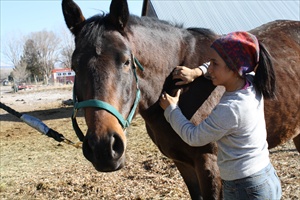The answer is, whenever you feel moved to do so.
When Rose and I were last at the chiropractor (more about that here), I asked her if she could give me some specific tips or “moves” I myself might use to help continue promoting Rose’s realignment and healing. I loved her answer because it was so in line with my own thinking and what I always tell my clients. She said something like:
“However you feel moved to touch or work on Rose will be effective as long as your intention to help her is there.”
Wow, that is so true. We can move mountains through intention. So touching for healing can be second nature.
I have been trained in using a couple of different bodywork techniques, have attended classes and workshops on such, and have watched my veterinarian perform absolute miracles on horses’ bodies many times with just the slightest touch. She has extensive training in many alternative modalities, but it is her intention that sets her apart from the crowd when it comes to results.

This all came to mind for two reasons: my own new rescue mare has a serious “outage” in her neck and I think has probably been in a lot of pain, translating into fear and behavior problems; and, one of my best friends has just adopted a beautiful and valuable warmblood gelding, a cast-off due to his very serious roach back (you can read about that here). Is my friend daunted? No way! Am I? A little. (It’s often easier to have more faith in someone else’s work than your own, you know.)
So I’m diving in with my mare, Lopeh, using what bodywork skills and techniques I have that I know are valuable, but mostly just following my gut — and Lopeh’s reactions. She loves it! There’s been lots and lots of yawning, licking and chewing, and she has begun to stretch out her front end by doing deep, straight-legged bows every morning. Best of all, her neck and back feel about 100 times softer than when she arrived here, and I can see subtle changes in her overall body. AND, the best of best of all, she’s lost her fear!
But what if your animal doesn’t respond so well? Or doesn’t want to be touched at all? You can still help them, a lot, by beginning with work in their subtle bodies, or auric field. We don’t end with our skin, you know. Our energy extends outward in several layers, all of which can be injured and damaged just like our physical being.
Here’s a technique I’ve suggested to many, many clients through the years whose animals are hard to touch but who obviously have major body problems. It’s easy, takes very little time, and the results are terrific.
SALT-WATER, AURIC BODY, HEALING TECHNIQUE
- Mix up a tepid, super-saturated salt solution in a small bowl. That means you keep adding salt to water until no more will dissolve. Salt varies hugely in its healing properties, so choose a good one — a natural sea salt from your local health food store would be good. Processed table salt is “dead,” so not so effective. It goes without saying that using high-quality water is best as well — no chemicals, please.
- Dip your hand(s) into the solution, shake them off (so you don’t drip on the animal), and begin stroking the animal in its auric field, out away from the skin. You will not touch the animal. Start with an area you know is hurting or injured and begin 2 to 3 inches out. Follow your instinct and work further away from the body if that feels right. Remember, the auric field extends waaay out from the physical body, so wherever you are led to move your hands, do so.
- Start with short sessions, daily or a few times a week — 3 to 5 minutes per session can be plenty. If working on a horse, start with small areas, gradually expanding to larger or different ones. After a week or two you should be able to cut down on your number of salt-water sessions AND to begin working on your animal’s physical body.
- Last but not least, DON’T BE SURPRISED IF YOU GET A HUGE REACTION WHEN YOU BEGIN THIS PROCESS. I’ve had people report that their horses literally jump away, or fall down, when they first use the salt-water technique, so be ready for anything.
As you can see, there’s a lot of leeway when helping your animals who need bodywork. So don’t be a weinie. Just get quiet, really focus, set your intention, and begin. Oh, and KEEP BREATHING!
Recent Comments